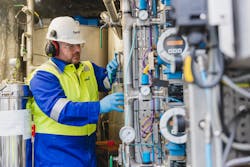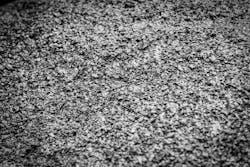Thermal drilling waste management system reduces cost, environmental impact
Andrew Morris, Gareth Innes, Adrian Clark and Pierre-Marie Hinden, TWMA
Laurie Phillips, AGR Well Management
Water-based and non-aqueous drilling fluids (NAF) and associated drill cuttings are the largest waste streams generated from global offshore drilling operations. Traditionally, the ‘skip and ship’ method is used to collect, contain, and transfer waste via vessel to a specialist processing facility onshore.
An alternative and increasingly attractive option, both financially and environmentally, is rig-based thermal processing through the TCC RotoMill. This uses frictional-based thermal desorption technology at source to separate NAF, debris, and associated materials into their three constituent parts of oil, water and solids for recycling, reuse, and safe disposal.
In 2018, drilling waste specialist TWMA was contracted by the license operator to mobilize drilling waste management services using offshore thermal processing for the 17½-in. and 12¼-in. Orlando production well drilling campaign in the UKCS. Managed by well operator AGR Well Management (AGR) using the semisubmersible drilling rig Ocean Guardian, the contract also included ‘skip and ship’ services for the 8½-in. section, due to operational requirements.
Rig-based drilling waste management
Located in block 3/3b in the northern North Sea, the Orlando field is more than 380 km (24-hours sailing time) from Aberdeen’s coastline facilities.
Due to the subsea infrastructure being installed shortly after the well was completed and suspended, drill cuttings and other debris had to be collected, removed and disposed of within a tight drilling window. With a total depth of 5,567 m (18,266 ft) to be drilled in the single subsea well, more than 1,600Mt of drilling waste was anticipated from the three sections.
Treating materials at source with thermal processing technology eliminates the requirement to transport waste long distances onshore via the ‘skip and ship’ method.
The process uses heat generated from kinetic energy to separate the three constituent parts of NAF and remove oil content. Using a hydraulically operated positive displacement piston pump, a cylindrical mill within the unit chamber grinds a bed of solids to generate power.
At a pre-determined temperature, NAF and drill cuttings are fed into the chamber causing the liquids (oil and water) to flash evaporate from the solids. The resulting gases then exit the mill and pass through a cyclone, where any fine solid particles are removed prior to gases travelling to the oil and steam condensers, respectively.
As the goal of the oil condenser is to recover the oil from the gases without condensing the water, the gases are cooled to approximately 105°C. Here, only the oil is condensed while the remaining gases containing water will pass through to the steam condenser. By further reducing the temperature to 40°C, the steam condenser will fully shrink the remaining gases. An integrated gravity separator then isolates any remaining light oil fractions to ensures this is removed from the recovered water phase.
Recovered base oil, which retains its full original quality, can be reintroduced to the drilling mud system, representing significant cost savings for operators. Recovered water and solids can be safely dispersed on location as they are well within with UK standards outlined in the Chemical Usage and Discharge permits issued by the Department of Business, Energy & Industrial Strategy and the Scottish Environmental Protection Agency (SEPA).
Thermal process versus ‘skip and ship’
There is a perception that mobilizing thermal processing equipment offshore on a one-well basis would entail high installation costs and involve installation and demobilizing around other drilling related activities. However, following a thorough evaluation of both methods, AGR found significant HSE and operational benefits:
• a reduction in skip handling
• a reduction in waste handling
• reduced weather exposure, i.e. limiting movement of skips on deck and to a dedicated vessel
• a reduction in the requirement for crane use
• no requirement for a dedicated vessel to be at the rig site during drilling
• the ability to re-use base oil in the drilling fluid at source.
AGR also undertook a commercial evaluation. Considering the reduction in time waiting on weather, removing the dedicated vessel requirement, and the reduction in logistics costs, it found that, even with the increased rental and mobilization costs, the overall costs could be 36% lower.
Reduced risk, cost and harm to the environment
Despite reduced crane availability, due to weather and other rig mobilization requirements, the offshore thermal processing package was fully installed within nine days, half a day ahead of schedule.
As space was limited on the Ocean Guardian, the thermal processing equipment configuration and layout design was the most compact installation performed to date. Having all the equipment within the same area in a smaller footprint allowed TWMA to achieve the most efficient processing.
More than 1,600Mt drill cuttings were processed from the three sections of the Orlando well: equivalent to 300 skips. This meant:
• a total of 1255.19Mt of recovered solids were diverted from landfill and discharged overboard with an average total petroleum hydrocarbon organics (TPH) of 0.058%, well below the North Sea allowable discharge of <1%
• a total of 223.37m3 of recovered water was discharged overboard with an average oil on water of 2ppm, also well below the North Sea allowable discharge of <30ppm.
By processing drill cuttings offshore at source, it was estimated that approximately 26 hours of weather downtime was removed during drilling operations, which would have resulted in an associated spread rate cost of approximately $380,000.
Consequently, this allowed continuous drilling during adverse weather conditions. It also significantly lowered handling, storage, offshore lifting and ‘skip and ship’ vessel requirements, saving an estimated $640,000 in vessel costs alone (based on the market rates at that time). Having the package onboard also gave the client flexibility leading to compressed schedules.
In addition, the solution minimized the HSE risks associated with the unloading and offloading of 300 skips, including more than 3,000 associated crane lifts, at the rig site, quayside and ultimately, the processing facility.
The drilling waste management operation was completed within time and on budget with zero Lost Time Incidents and zero loss of containment to the environment during operations.
The offshore thermal desorption unit performs at processing speeds of up to 10Mt per hour in even the harshest offshore environments and reduces heavy labor lifting operations by up to 95%. Compared with the traditional ‘skip and ship’ method, it also delivers significant cost savings of up to 40% per well. Most notably, it can cut carbon footprint by more than half.
The first single well operation on the Orlando field has proven that onsite thermal processing can safely increase operational efficiency, support well cost reduction initiatives, exceed regulatory requirements and mitigate the likelihood of safety and environmental incidents.
TWMA has since secured five offshore processing contracts with the TCC RotoMill in the UKCS total more than $20 million. These awards demonstrate the markets outlook at using offshore thermal processing technology and further validates the value this technology can brings to customers’ operations in terms of safety, operations, and commercial aspects. •

